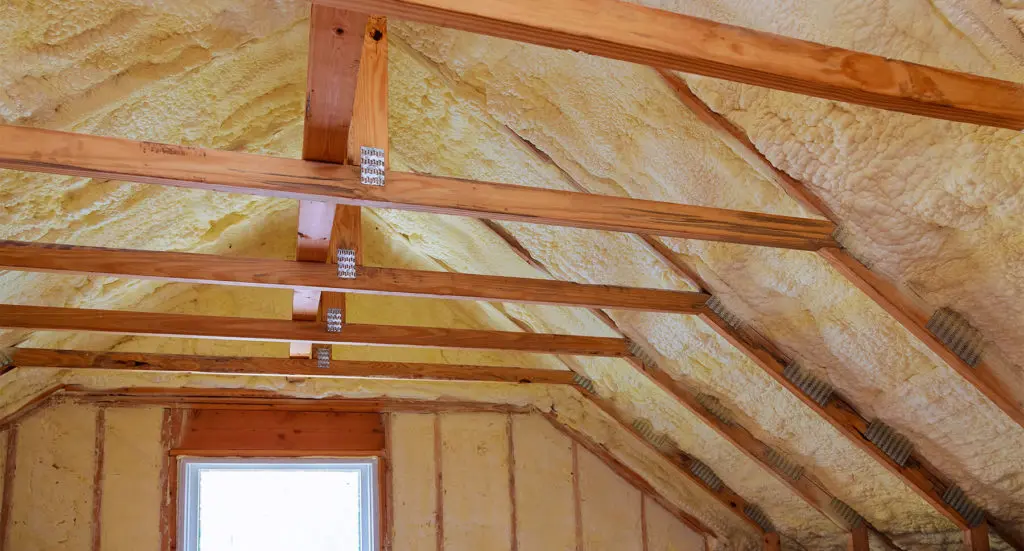- Jamie Hager
- April 14, 2021
- 9 Minute Read
Topics in This Article
Attic Sealing in a Mixed-Humid Climate
Spring is here! As we welcome the longer days and beautiful NC weather (except for the pollen!), we also know that heat and humidity is on the horizon. High-performance home builders in NC are uniquely challenged by our mixed-humid climate to deliver healthy, energy efficient, resilient homes.
Building with a sealed attic is an option that many explore for multiple reasons — tighter envelope, getting ducts into conditioned space, decreased attic temps — but it does come with potential issues. In this post, we explore best practices for sealing an attic and the strategies that need to be implemented to avoid rot, condensation, and moisture problems.
Should you seal the attic in the first place?
To vent or not to vent — that is the first question. While I am going to focus on best practices for a sealed attic, it should not be assumed that sealing the attic is always the best way to go. Vented attics done right can offer more insulation in the ceiling, still deliver a very tight building envelope, and with the addition of a radiant barrier, can have manageable temperatures for storing those Christmas decorations. Cost also plays its part, as creating a sealed attic tends to cost more than it’s vented counterpart. So what makes a project a good sealed attic candidate? Here are a few questions to consider to help weigh the pros and cons:

What are you doing up there?
Will your HVAC be located in the attic area or is there another way you may be able to bring your equipment and ducts into conditioned space (like that cozy sealed crawl space you provide as a standard)? Is your attic actually an unfinished bonus room that you plan to insulate in the near future? Is attic storage at the top of your client’s “want” list or just a nice to have? The cost of sealing an attic may not see it’s return on investment if not much will be done in that space.

How complicated is your roofline?
Does your homeplan have large vaulted or cathedral ceilings? Do you have tall open foyers or varying ceiling heights that may prove a challenge to insulate with batts or blown insulation? If so, sealing the attic could be a better option for you. Conversely, if you have a flat ceiling plane easily insulated with batts or a ranch home with lots of attic volume, insulating at the roof deck could be pretty expensive when insulating at the ceiling plane will do just fine.

Admit it - You’re obsessed with can lights.
Is recessed lighting your jam and you simply cannot live without at least a dozen of them in the ceiling between conditioned and unconditioned space? You may laugh but I’ve seen it, and even gasketed can lights contribute to air leakage when the sheetrock is your air barrier. There are flush mounted lights that can have the look of recessed lighting without the large holes, but the point here is that if you know you will have above average penetrations through the sheetrock that could make air-sealing difficult, moving the air barrier to the roof deck could be something to consider.
Unvented Attic Assemblies That Don’t Rot
You have decided that an unvented attic assembly is the way to go, but were you aware that they can easily fail within a year or two if not done properly? It would be a shame to have gained the extra space and pleasant HVAC living environment, only to have to replace a rotten roof due to condensation on the underside of the roof sheathing. So what causes this condensation and rot, and how can you avoid it?
3rd Rock from the Sun
Unfortunately, the fiberglass insulation you are used to using in your ceilings cannot simply be “moved” to the underside of the roof sheathing without venting or a means to keep the roof sheathing warm, otherwise you will get condensation. Why? Space. Outer Space — is cold! (Like -450 degrees Fahrenheit cold!) And because the laws of thermo-dynamics state that heat always flows from warmer objects to cooler objects, roof sheathing exposed to a clear night sky will radiate (lose) heat to the ridiculous coolness of space.

Studies show that because of this phenomenon, called night sky radiation, a roof facing the night sky can be 6°C to 22°C colder than the surrounding air temperature. In our mixed-humid North Carolina climate, that is enough of a temperature drop to reach dew point – the temperature point at which water vapor condenses onto a surface – depending on the temperature and humidity of the attic air.
Code Requirements for Condensation Control
Two things are needed for condensation to occur — air with water in it and a surface cool enough to pull that water out (ie, hit the dew point). Therefore, to prevent condensation you need to either control the temperature of the material’s surface, the amount of water vapor in the surrounding air, or both.
Miracle of miracles –building code and building science align on this issue. The four code approved insulation strategies for unvented attic assemblies prevent condensation by ensuring that attic air does not come into contact with a cool surface. They are listed in Chapter 8 – Section R806.5 of the 2018 NC Residential Code and are as follows:
Air Impermeable Insulation Below
Insulation that is impermeable to air (air cannot pass through it) is applied in direct contact with the underside of the roof sheathing to code minimum ceiling insulation requirements (R38). This is most commonly achieved with spray foam insulation. Open and closed cell spray foam are both acceptable, but extra measures need to be taken with open cell. More about that later.
- Shingles
- Roofing Paper
- Roof Sheathing
- Air Impermeable Insulation (Spray Foam)
Air Impermeable Insulation Above
Insulation that is impermeable to air is installed directly above the structural roof sheathing to code minimum requirements (R38). Rigid foam insulation installed above the roof sheathing, although not common practice, is the preferred method amongst the building science community. This method should be considered during design as it can make for challenging eave and soffit details.
- Shingles
- Roofing Paper
- Roof Sheathing
- Rigid Insulation
- Air Barrier Membrane
- Roof Sheathing
- Rafter / Truss
Combo 1 Ratio of Above and Below
Air impermeable insulation is installed above the roof sheathing to the minimum R value requirements in Table R806.5, and air-permeable insulation (such as fiberglass or cellulose) is installed directly under the roof sheathing until total required R38 is achieved. The minimum R values in the table AND the ratio of rigid insulation to air permeable insulation must be maintained or it will not keep the sheathing warm enough to prevent condensation.
- Shingles
- Roofing Paper
- Roof Sheathing
- Rigid Insulation
- Air Barrier
- Roof Sheathing
- Air Permeable Insulation (Fiberglass Batts, Blown Fiberglass, etc.)
Combo 2 Ratio All Below
Air impermeable insulation is installed in direct contact with the underside of the roof sheathing to the minimum R value requirements in Table R806.5, and then air-permeable insulation is installed below and in contact with it until minimum ceiling R values are achieved (often called flash and batt). Again, the spray foam must meet the minimum R values in the table AND the ratio of spray foam insulation to air permeable insulation must be maintained or it will not keep the sheathing warm enough to prevent condensation.
- Shingles
- Roofing Paper
- Roof Sheathing
- Air Impermeable Insulation (Spray Foam)
- Air Permeable Insulation (Fiberglass Batts)
If you plan to exceed code insulation levels or are not able to install the insulation to meet the prescriptive requirements above, give us a call so we can model a custom solution for you that will still work.
Insulation for Condensation Control
To ensure condensation control, air-impermeable insulation must meet a portion or all of the code required ceiling insulation R-value (R38/R30ci) for the climate zone. Minimum required R values of air-impermeable insulation for each NC climate zone are listed in the chart below:
Table R806.5 (2018 NC Residential Building Code)
| Climate Zone | Minimum Rigid Board On Air-Impermeable Insulation R-Value (a,b) |
|---|---|
| 1, 2A, 2B, 3A, 3B, 3C | R-5 |
| 4C | R-10 |
| 4A, 4B | R-15 |
| 5 | R-20 |
a. Contributes to, but does not supersede the requirements in Section 1102
b. Alternateively, sufficient continuous insulation shall be installed directly above the structural roof sheathing to maintain the monthly average temperature of the underside of the structural roof sheathing above 45 degrees F. For calculation purposes, an interior air temperature of 68 degrees F is assumed and the exterior air temperature is assumed to be the monthly average outside temperature of the three coldest months.
Open Cell Spray Foam Needs Humidity Management
The most common method we see used for sealed attics is open cell spray foam applied to the underside of the roof sheathing. Over the last few years, reports of high humidity levels in open cell spray foam attics have become more common and the building science community has been hard at work to understand why and where this humidity is coming from.

I’ve been following the Building Science Corporation and Green Building Advisor (a couple of my go-to technical resources) on the issue and if you’d like to do a deep dive, this article by Allison Bailes does a great job of pulling the science together. For the rest of you, here’s a quick summary of what is causing high humidity levels in open cell spray foam attics:
- Higher humidity in open cell spray foam attics is a common problem
- Open cell foam, while an air barrier, is vapor permeable which means it allows interior moisture in the air to migrate to the wood roof sheathing
- At night when the roof cools down, moisture in the air inside the attic migrates through the open cell foam to the wood sheathing, which is able to absorb more moisture when it is cooler
- During the day when the sheathing warms back up, the wood cannot hold the moisture and it migrates back through the foam into the attic air, increasing the humidity level of the air. Basically, the wood sheathing is kind of like a sponge– able to hold moisture at night and then releases it back during the day. This cycle happens every day.
Solutions Provided
There are two main ways to prevent moisture related issues from this phenomenon:
- Use closed cell instead of open cell foam against the roof deck
- If using open cell spray foam, condition/dry out the attic air to lower humidity levels
Because the water vapor migrating through the open cell spray foam is originating from inside the building envelope, intentionally managing the attic air can bring humidity down to acceptable levels. Dr. Joe Lstiburek of the Building Science Corporation recommends supplying air at a flow rate greater than or equal to 50 cfm per 1000 ft2 of ceiling using one of the following methods:
- Provide supply air from the HVAC system to the occupiable space when the conditioning system is operating
- Supply air to the attic by a fan blowing air from the occupiable space into the attic
- Provide mechanical dehumidification to the unvented attic air space
What's Next?
The key to a successful sealed attic can be summed up in two words — warm and dry. If you are planning to build an unvented attic assembly, we’d love to be part of your high performance team.
Ready to Get Started?
Schedule a meeting with us today to review your home performance goals and challenges.
About Us
North Carolina’s solar power and building performance expert. Founded in 2001, we’ve worked for 20+ years to improve the way people make and use energy.
© 2023 Southern Energy Management, Inc.














